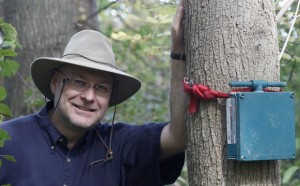By Katrina Marland
You’re watching a movie. The leading characters are out in the woods, hiding from some monster or another, and all of a sudden everything goes silent. No birds chirping, leaves rustling or twigs snapping — all of it stops, and you know something bad is about to happen. Turns out, this isn’t just a cinematic trick, the sounds of nature can be as important as any other factors in predicting trouble in an ecosystem. This science of analyzing nature’s sounds — called soundscape ecology — is a fairly new idea, and a fascinating one.
Ecologist Bryan Pijanowski of Purdue University is working at the forefront of this new field, and is passionate about its implications. “Natural sound could be the canary in the coal mine,” he says in a recent press release. “Sound might be the critical first indicator of changes in climate and weather patterns, or the presence of pollution.” Pijanowski and his colleagues will be getting a chance to study these soundscapes and their meanings further, thanks to a grant from the National Science Foundation’s (NSF) Dynamics of Coupled Natural and Human Systems Program.
So far, Pijanowski’s team has mapped soundscapes in a variety of ecosystems, from wetlands in Indiana to California’ Sequoia National Park. He and his team set up recorders and use the resulting data to create a plot of acoustics, turning sound into a three dimensional map of the area. Changes on the maps over time reflect changes in the ecosystem, whether as natural as the changing of seasons, or as abrupt as a human disturbance. You can view his research and listen to the project’s many recorded soundscapes here.
In addition to the ecological significance that the soundscape of an area can hold, Pijanowski is quick to point out that the sounds themselves hold great value, as they create a link between humans and our environment in a society where that connection seems to be waning. It’s true that we often tune out the sounds of our environment, and this means that we miss the opportunity to hear a song that may never be played again. Each region’s soundscape is a snapshot; it can change every year or every day. With the various natural and man-made threats facing the environment today, many species are being quietly silenced. It may be more important than ever to take some time to simply listen.
